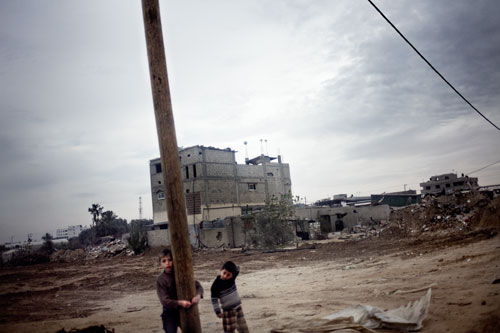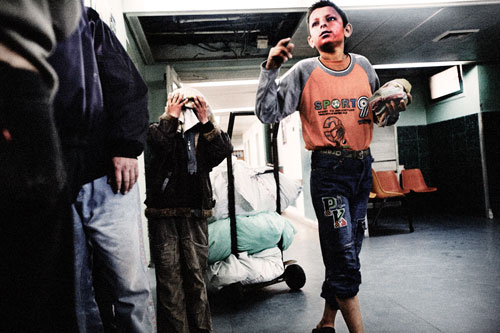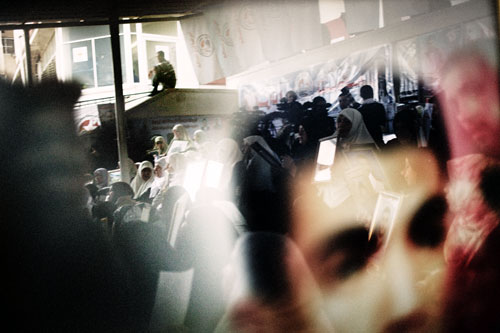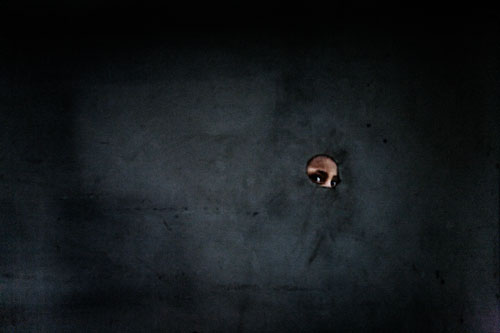
- A Palestinian boy plays hide-and-seek behind a wall shelled by the Israeli Defense Forces during Operation Cast Lead.
Israeli ground troops withdrew from the Gaza Strip on January 21, 2009—four days after a ceasefire ended a twenty-three day offensive against Hamas, codenamed Operation Cast Lead. The devastating campaign left over 1,400 Palestinians dead and more than five thousand wounded. Some six thousand Palestinian homes were also destroyed, leaving countless families without shelter in the middle of a wet and blustery winter. Gazans were in a state of emergency—but that was nothing new. Four decades of Israeli occupation, two Intifadas, and a near-total Israeli blockade had combined to make “emergency” Gaza’s natural state.
New York-based photographer Gabriele Stabile, originally from Sicily, shot these photographs in March 2009. That month, a wave of spring thunderstorms flooded Gaza’s unpaved streets and blew down relief tents for families displaced by Cast Lead. I was in Gaza that March, too, and had been there since January. When I arrived, Gazans were still pulling bodies from the rubble; by March they were bent to the task of rebuilding their communities. They faced enormous challenges; most significantly, the blockade meant that Gazans had to contend with the absence of building materials, like cement and steel, and crippling shortages of cooking gas and industrial diesel for power generation.
Gaza is normally a warm and sunny place, but my memories of the first months after Cast Lead are illustrated almost entirely with gloomy landscapes like Stabile’s image of two boys standing before a string of ruins in Zeitoun. A blanket of clouds presses down, oozing cold rain. Israeli tank tracks have been replaced by those of Palestinian machinery brought in to cart away the remnants of ceilings, walls, kitchens, and bedrooms. The wounded landscape in the photo evokes Palestinians’ scarred cultural consciousness; these homes represented lifetime investments of labor and generational promises from fathers to sons. “These kids,” Stabile says, “they’re never going to get rid of those memories, or of the feeling of having been robbed.”
Children under eighteen make up half of Gaza’s 1.5 million residents. Zeitoun’s children bear more scars than most—it was there that twenty-nine members of the Samouni family, including ten children, died at the hands of the IDF in a macabre collage of incidents known to Palestinians as the Zeitoun Massacre. The UN and the International Committee of the Red Cross verified the Samounis’ story, but justice is unlikely; Israel denounced the Goldstone Report and has never admitted to wrongdoing in Zeitoun.
Stabile gives us an abstracted glimpse of the Samouni kids’ scars in his picture of a boy peering through a hole in his home left by Israeli shelling. The boy’s gaze is playful and yet vaguely threatening. What we don’t see is the scene that unfolded moments before Stabile released the shutter: a mob of Samouni boys torturing a cat to within an inch of its life. The boys, including the subject, hid behind a wall to escape an angry adult who discovered them. “At the end of this crazy game, they had almost killed that cat, and I couldn’t believe it,” Stabile remembers. “Then I realized that, in a place that’s so violent, where reality is so extreme every day, this is probably conceivable.”
Three of Stabile’s photos come from Al Shifa Hospital, where Stabile based himself to observe a “cross-section of society.” Al Shifa— constructed as a barracks during the British mandate and expanded during the subsequent Egyptian occupation of Gaza as a health center— is as prominent a landmark in Gaza City as the ancient Great Omari Mosque. The name translates to “healing,” which is not the only thing Gazans go there to do; militant rallies terminate at the morgue of Al Shifa whenever a fighter dies in combat, for example. Many Gazan lives also begin at Al Shifa, and a portrait of a life could be drawn from visits to the hospital over the years. Stabile shows us a man resting on a windowsill, anxiously awaiting a visit with his sick child. It is probably not the first time the man has visited Al Shifa, and it won’t be the last. His children were likely born there; he and his wife will seek treatment there as they grow older and require specialized care; if they are fortunate, their grandchildren will be born at Al Shifa too.
Stabile focused his attention on Al Shifa’s emergency room, which treats approximately 120 patients daily. The doctors “would joke that whatever would come in, they would put a cast on it,” Stabile remembers. “But it was actually a pretty depressing time. Seventy percent of the patients were children under sixteen. These kids run barefoot, get run over by cars, smash their heads against the ruins of the city. I mean, it’s a totally unfriendly environment.”
These are not the only threats to Gazan youth. Stabile shows us two boys badly burned in a kerosene explosion, an all too common occurrence in Gaza. Gazans have responded to the critical shortage of high-quality cooking gas caused by the blockade by smuggling in low-grade, highly volatile kerosene from Egyptian tunnels; the result is that kerosene accidents now account for more civilian injuries than Israeli violence. One day, Stabile saw a young boy come in with a deep cut on his back and discovered that the boy had been stabbed on his way to school. Another day, the corpses of three boys arrived at the morgue. Hamas policemen accompanying the ambulance cried, “The Israelis did it! The Israelis did it!” The policemen rushed to make child martyrs out of the boys, but Stabile later learned from his translator that one of the boys had accidentally stepped on an explosive device planted by Palestinian militants.
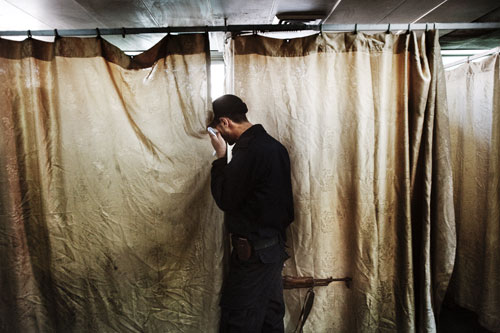
- At Al Shifa Hospital, a Hamas policeman, who escorted a young family member to the emergency room, wipes away tears.
Al Shifa became for Stabile “kind of like a catalyst, one of these places where you can witness a very intense sense of sorrow—rich with humanity but often frightening.” In one photo, a Hamas policeman sobs as doctors treat a relative. “People from everywhere can relate to this: seeing a grown man crying is always heartbreaking, especially if it’s someone whose daily challenges are far tougher than the ones we experience.” Lest our sympathies carry us too far, however, the Kalashnikov dangling from the man’s hand reminds us of the brutal power he represents in Gaza, where an authoritarian Hamas government doubles down the oppressiveness of the Israeli blockade.
At their best and most startling, Stabile’s images reach beyond Gaza to represent the plight of Palestinian youth on the whole—for we might as well imagine the Samouni boy peering at us from behind the separation wall that runs the entire length of Gaza’s border with Israel and much of the border between Israel and the West Bank. The gaze is a challenge to our naïveté. We want to see only a victimized child behind the wall; we do not want to imagine how that child’s trauma might harden his heart beyond rescue.
“At the entrance to the ER there’s always a little group of two or three Hamas policemen,” Stabile tells me. “It’s weird because when they would talk they would be staunch defenders of Hamas. And then, my last day at Shifa, they were all like, ‘Jibril! Take me with you!’” Stabile laughs. “Human beings save the best for the end, in a way,” he says. “They show you, in your last seconds together, what they really have inside, which is: ‘Get me the fuck out of here, because I can’t stand this anymore.’”
Elliott D. Woods’s essay “Hope’s Coffin,” about Operation Cast Lead, appeared in the Summer 2009 issue and received a citation for the Madeline Dane Ross Award from the Overseas Press Club.



